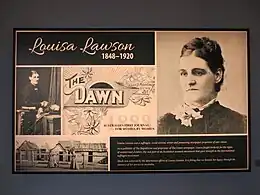Lightbox
A lightbox is a translucent surface illuminated from behind, used for situations where a shape laid upon the surface needs to be seen with high contrast.[1]

Small lightbox opened to reveal workings
Types

Wall mounted lightbox for inspecting medical X-rays

Lightbox used in outdoor advertising

Lightbox designed to produce images with diffuse lighting from all angles

Lightbox used as a Memorial Plaque
Several varieties exist, depending on their purpose:
- Various backlit viewing devices:
- A container with several lightbulbs and a pane of frosted glass on the top. It is used by photography professionals viewing transparent films, such as slides.[2] This device was originally used to sort photographic plates with ease. When laid flat, it may be called a light table. Generally, a lightbox uses light similar to daylight (5,000–6,000 kelvins (K)) and has uniform light strength on the glass pane.[3]
- In the form of vertical panels, they can also be found mounted on the walls of hospitals and medical offices to review X-ray images (X-ray illuminator).[4]
- In the science field, lightboxes are often used for looking at bacterial growth and allow better visualization for PCR plates.
- A lighted display panel used for advertising purposes.[5] The panel can be illuminated by fluorescent light bulbs or LED lighting strips. The efficiency of light boxes improved dramatically after the introduction of LED technology. The user inserts a graphic, which can be changed easily. Some light boxes are designed especially for outdoor purposes so they are more weatherproof.
- An advertising format at Google Ads that allows users to click and expand an ad in order to engage with it.[6]
- The fabric reflectors that attach to studio lighting via a connector to create soft lighting by diffusing the strobe flash are called "light boxes".[7] They generally come in various rectangle or octagon shapes. Interior reflectors can be white, silver or gold to alter the temperature of light. Baffling inserts are also available.
- A variation of this is a box, with one open end, made of diffusing material, to allow the photographing of a sample object with no shadows. It is also called light tent or photo cube.[8]
- A folder used on stock photography to allow a user to organize digital photos. Photos can be assigned to a viewable lightbox folder by subject, for later convenience, or used to compile unrelated photos for a specific project layout. Lightboxes also allow graphic designers to show clients options for a project in one simple uncluttered folder.[9]
- The card-reader near the door in a hotel room, used as the main electric switch
References
Wikimedia Commons has media related to Lightboxes (photography).
Wikimedia Commons has media related to Light boxes (signs).
Look up lightbox in Wiktionary, the free dictionary.
- Tony White (20 June 2014). Animation from Pencils to Pixels: Classical Techniques for the Digital Animator. CRC Press. p. 309. ISBN 978-1-136-14422-6 – via Google Books.
- Modrak, Rebekah; Anthes, Bill (2011). Reframing Photography: Theory and Practice. Taylor & Francis. p. 453. ISBN 9780415779197 – via Google Books.
- Saddington, Roger (2003). The Quick & Easy Guide to Photographing Your Artwork. Penguin. p. 61. ISBN 9781440317507 – via Google Books.
- Al-Azzawi, Abdul (2017). Photonics: Principles and Practices. CRC Press. p. 282. ISBN 9780849382949 – via Google Books.
- Travis, Lily (July 12, 2018). "Light Box Signs And Their Unexpected Benefits For Your Business". frontsigns.com. Retrieved May 17, 2021.
- "About Lightbox ads". Google. Retrieved May 17, 2021.
- Andrews, Ben; Stapley, Jon (August 29, 2020). "The best light tents for photography". digitalcameraworld.com. Retrieved May 17, 2021.
- Elizabeth, Diana (December 3, 2013). "3 Great Ways to Utilize a Light Cube". photography.tutsplus.com. Retrieved May 17, 2021.
- Bartosz Porebski; Karol Przystalski; Leszek Nowak (17 February 2011). Building PHP Applications with Symfony, CakePHP, and Zend Framework. John Wiley and Sons. p. 259. ISBN 978-1-118-06792-5 – via Google Books.
This article is issued from Wikipedia. The text is licensed under Creative Commons - Attribution - Sharealike. Additional terms may apply for the media files.